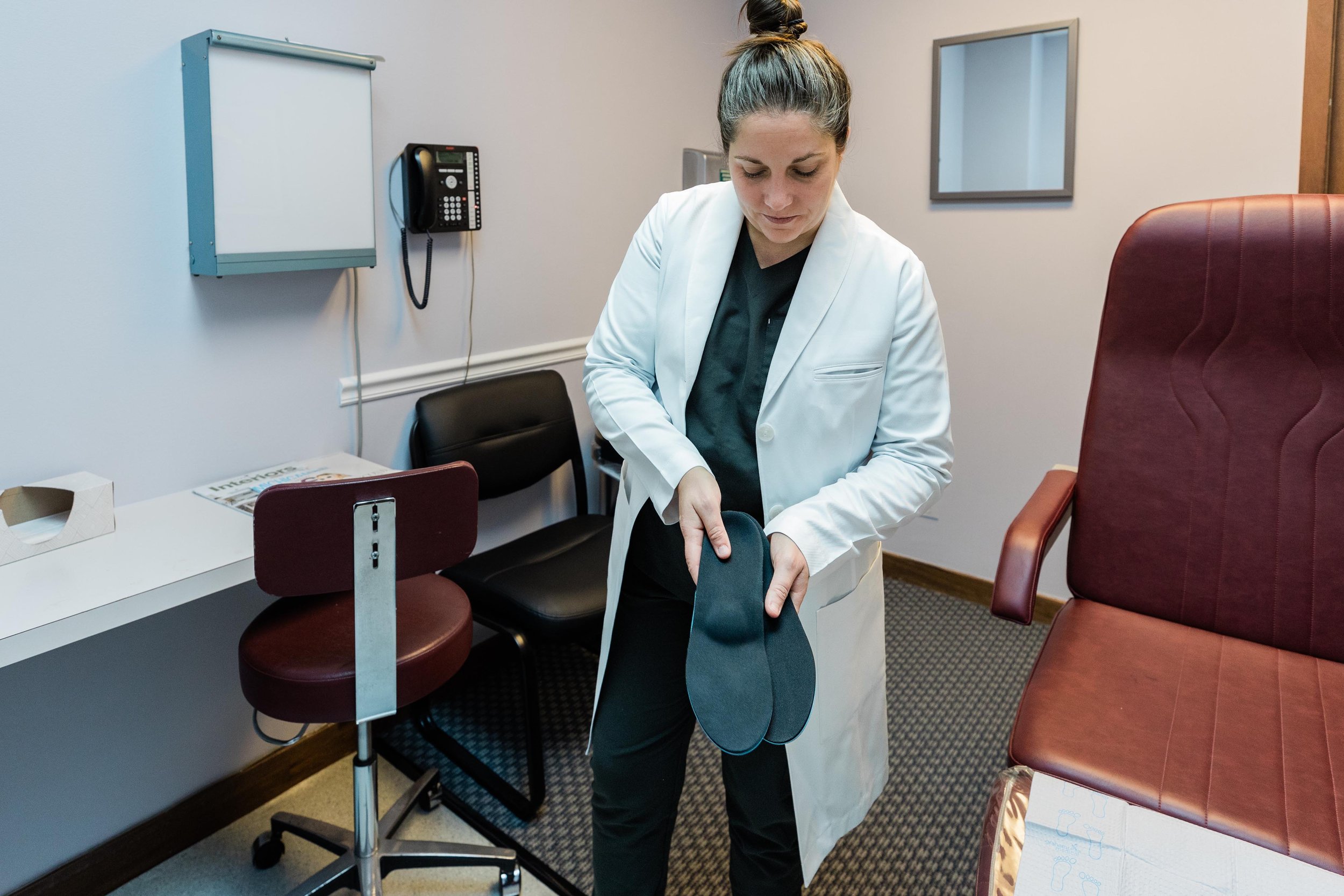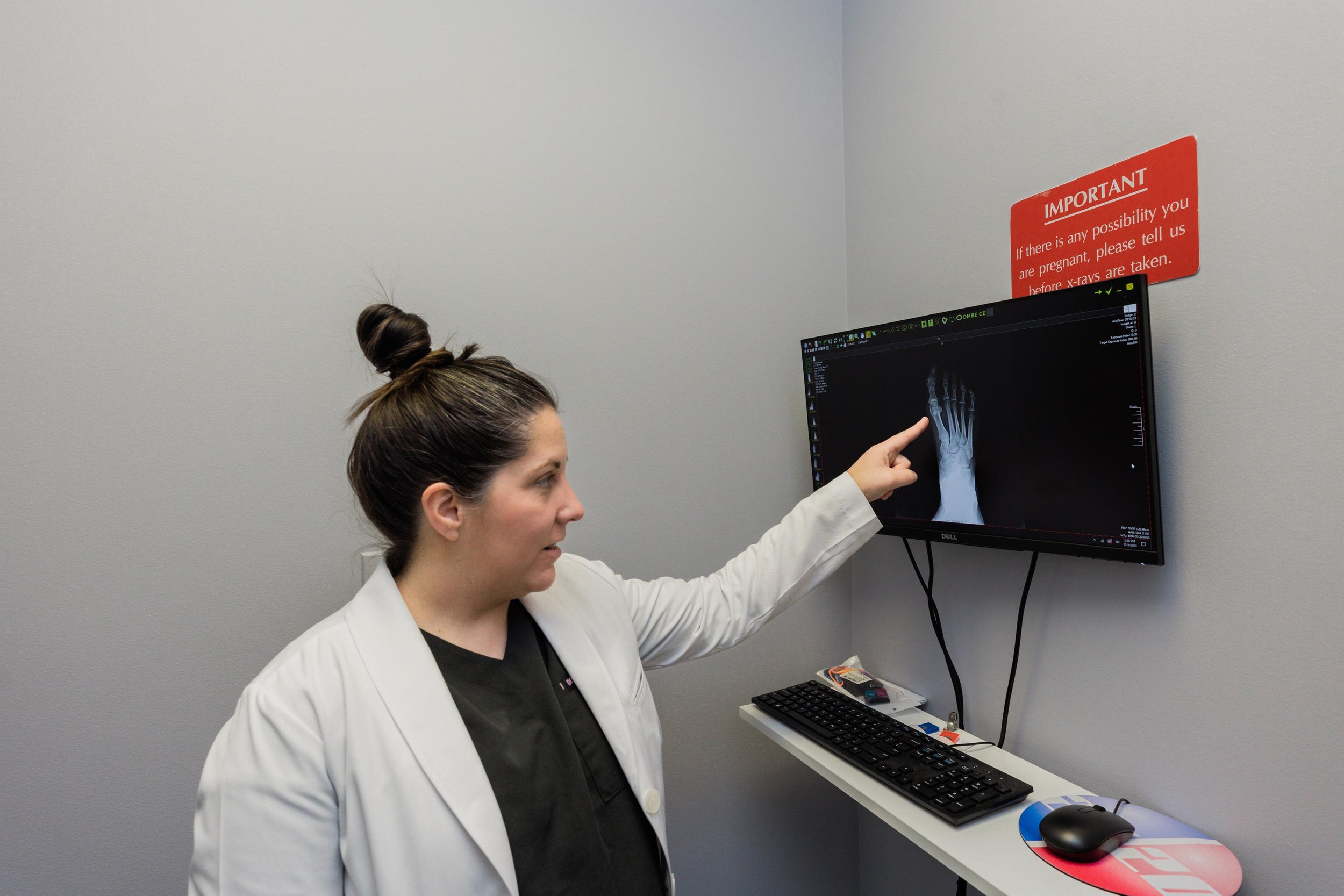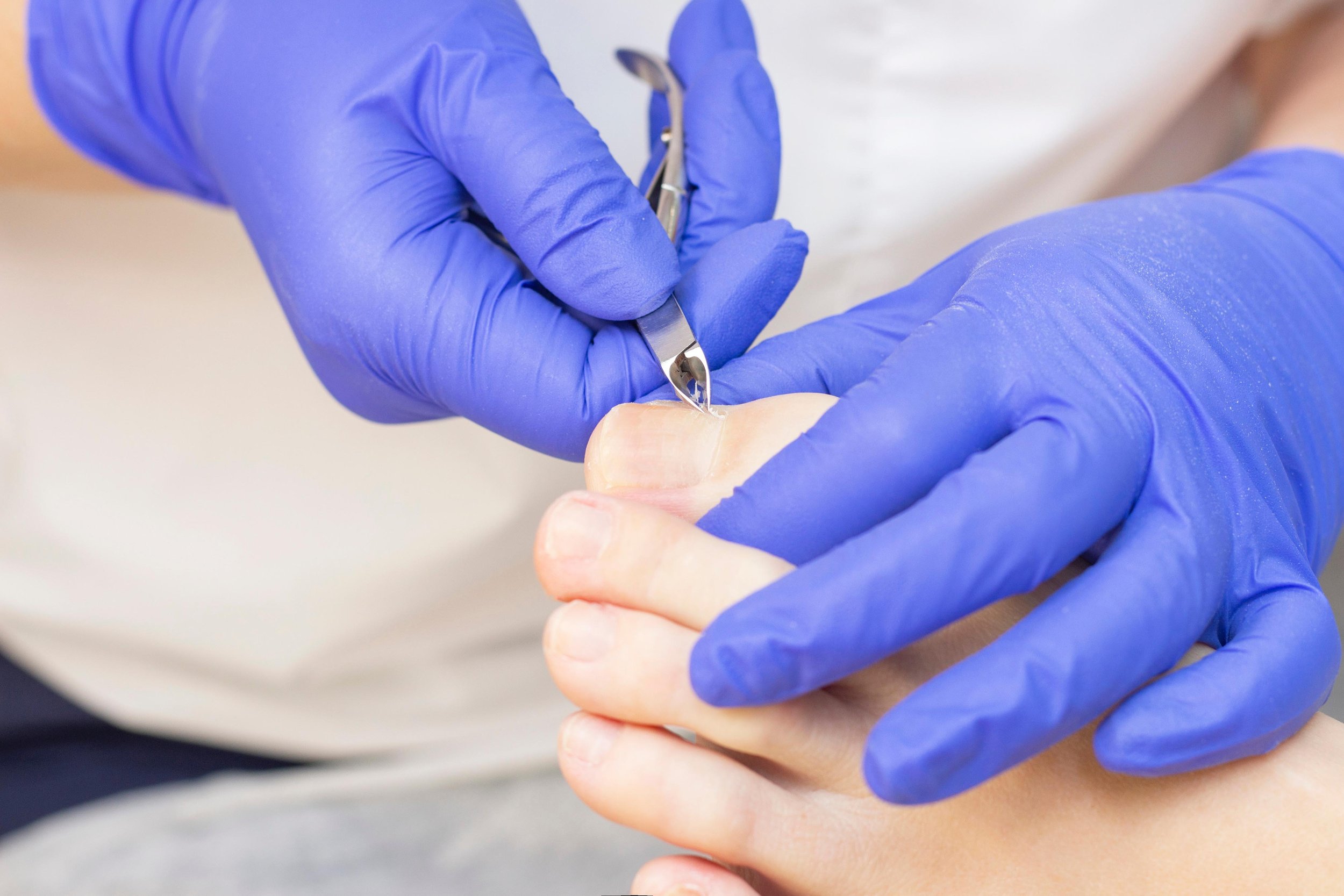You Need a Podiatrist in Chicago. Learn How a Podiatrist Can Help You Live Your Best, Most Active Life.
The Windy City is a dynamic place to call home. From the music and arts to the food scene—it’s a vibrant city that’s cemented its well-deserved place as one of our nation’s cultural hotspots.
You're also well aware that Chicago is an ideal place for active people to reside. With hundreds of parks and miles of beautiful lakefront to explore and enjoy, it’s an ideal location to nurture your physical fitness and mobility, all while surrounded by beautiful scenery.
From Lincoln Park to the Riverwalk, you’ve got no shortage of ways to have fun staying active in Chicago.
As the third largest city in America, Chicago boasts a healthy population of enterprising young professionals, who help make this city what it is.
If you count yourself among their ranks, it’s likely you work as hard as you play, and you may find yourself pounding the pavement both literally and figuratively as you enjoy your personal and professional life in this exciting backdrop.
But here's the thing—folks who stay as active as you are at risk for experiencing foot and ankle issues that can quickly sideline you from being a firsthand participant in the lifestyle you so enjoy in this fast-paced city.
Your feet and ankles are the very foundation of your mobility and active life—whether you’re walking, running, dancing, or biking, they’re how you get around.
When you experience pain or discomfort in your feet and ankles, it can do more than throw you off your pace—it can lead to bigger issues down the road if not addressed and ameliorated.
Thankfully, Chicagoans like you also have access to the best in health, wellness, and medical care that a cosmopolitan setting affords.
When you’re young and active, a podiatrist may not be a medical professional who’s on your healthcare radar. But they should be.
Because the right podiatrist can ensure you live your best, healthiest life in Chicago—both now and into your bright future.
This article will explore how a podiatrist can support you and why you should consider connecting with a podiatrist in Chicago.
Let’s start by dispelling some common misconceptions about podiatry and what podiatrists do.
9 common misconceptions about podiatry and foot health
01. Podiatry is only for older people
Look, many older folks do benefit from podiatry services and treatments. But that doesn't mean they’re the only population of people who need podiatry care.
People with diabetes and those who love sports and maintaining an active lifestyle often run into foot and ankle issues that can affect their mobility and life.
City Step Podiatry’s Dr. Alison Young, DPM specializes in supporting those with diabetic foot issues and also loves treating runners and active young people. She’s even connected with patients at the finish line of the Chicago Marathon and gone on to help them recover from acute-on-chronic running-related injuries.
When you experience foot and ankle pain—it doesn't matter what age you are. Discomfort in your feet and ankles that goes untreated can sideline you from fully living the life you want to live. And nobody has time for that.
02. Podiatrists aren’t really doctors
Podiatrists are not only doctors, they're specialists.
Their official title is Doctor of Podiatric Medicine, abbreviated as DPM. To obtain this title, they must complete four years of undergraduate studies, four years of podiatry school, and three years of residency with surgical training. Podiatrists must also obtain their licensure to practice in their chosen state and they can also opt to become board certified, though this isn’t a requirement to practice.
Interested in learning more about how podiatrists train and what they can offer you? Check out our deep dive article, exploring the field of podiatry and how podiatrists help.
03. Podiatrists can’t do surgery
Not true! In fact, most podiatrists are qualified to perform surgical procedures on the feet and ankles and, in some cases, they can even perform these procedures right in their office. When a necessary procedure is out of their scope or expertise, they can help streamline the treatment process by making referrals to qualified specialists.
City Step Podiatry’s Dr. Alison Young, DPM is skilled in surgical interventions for foot and ankle conditions and completed her three-year surgical residency at AMITA Sts. Mary and Elizabeth Medical Center, right here in Chicago.
Learn more about Dr. Young’s experience, credentials, and care philosophy by visiting our website.
04. Foot and ankle pain tends to resolve on its own
In some cases, this may be true. But are you willing to take that chance if it means gambling not only your health but your mobility?
Your feet and ankles have a big job. We tend to expect a lot from them. When you have pain in your feet or ankles that’s persistent, severe, or just plain throws a curveball into your daily routine—you don’t need to accept it and simply try to live with it. A podiatrist can help you pinpoint the cause of your pain and discomfort and create a treatment plan to address it for you.
Many treatments used by podiatrists are quick and even enjoyable to experience. At City Step Podiatry, this includes our Remy class IV laser therapy treatments, which deliver powerful healing and pain relief with a warm, soothing laser that targets foot and ankle pain and inflammation at the source in a series of easy, five-minute treatments.
Our Radial Shockwave Therapy may also be the ideal treatment for your foot and ankle pain. This cutting-edge treatment is a fast and effective way to promote healing and enhance circulation in your feet and ankles.
05. Those over-the-counter shoe inserts are just as good as custom orthotics
Which type of suit would fit you best—one off-the-rack from a department store or one made to measure by a bespoke tailor? Not a ton of guesswork involved in that scenario, right? It’s the same equation with custom orthotics. While you’ll probably experience some benefits when you buy general shoe inserts, it’s not the same as getting orthotics that are custom fit to your feet and your feet, alone.
At City Step Podiatry, our custom orthotics are tailor-made for you and designed to offer you the personalized support you need to feel your best. Dr. Young starts by performing a thorough consultation and exam, taking time to get to know you and your lifestyle needs, and listening to your concerns. She’ll assess your gait and may obtain an X-ray to get a solid sense of your feet and their unique needs. Next, she’ll take a custom cast of your foot in its optimal position using a special type of sock. Once your foot mold is cast, we’ll send it to our custom casting lab.
Your City Step custom orthotics are usually ready for you to try in 2-4 weeks. You’ll stop by the office to try them on and we’ll make any adjustments at that time. Then, you’ll wear them for 4-6 weeks to make certain they’re the perfect fit for you. If any more modifications need to be made, we’ll be happy to provide them. Because we want to ensure your custom orthotics deliver you the comfort and care you deserve.
Interested in learning more about our custom orthotics for active Chicagoans like you? Learn more about this signature service on our website.
06. Toenail fungus is cosmetic and can be easily treated at home
In some mild cases, home treatment may be effective for treating toenail fungus. But many fail to understand the true nature of this issue—to their detriment. That’s because foot fungus is a type of fungal infection. And, like many types of infection—it’s highly contagious and can spread.
Without proper treatment, it may start with one toe and quickly spread to impact others. So, instead of one thick, discolored toenail—you’ve got an entire foot-full of them. And that can really throw a monkey wrench into your plans for sandal season.
Toenail fungus is not only cosmetic—it can undermine the integrity of your toenails over time, causing them to break down and crumble. And that’s bad news for your overall foot health and wellness.
Thankfully, your podiatrist has treatments that are designed to target and eliminate toenail fungus at the source—so you can feel confident in both the health and aesthetics of your feet.
07. Going barefoot is beneficial for your feet
On the surface, this seems to make logical sense. That’s probably why it’s such a pervasive myth about foot health and wellness. Here’s the truth—while going barefoot can help your feet recover from ill-fitting shoes, rubbing, and pressure, it’s not optimal for several reasons.
Being barefoot can open your feet up to increased risks for issues like fallen arches and fungal infections. For those with high arches or other issues with foot positioning, going barefoot may put your feet in non-optimal postures, which can lead to pain and other issues.
Particularly for folks with health conditions like diabetes, going barefoot can be an extremely risky endeavor that’s best avoided whenever possible. People with diabetes are especially susceptible to issues with wound healing—so protecting your feet with proper footwear is vital to reduce these risks.
08. Foot pain is just a normal part of aging
Oh, the things we’re told to just accept as part of the aging process! Like many things—foot pain isn’t something you should simply grin and bear. And it’s not a normal part of aging.
When you experience foot or ankle pain, scheduling an appointment with a podiatrist can be a great way to prevent small issues from snowballing into larger, more chronic injuries. It’s unwise to gamble with your mobility, especially as you age and begin to realize just how important and precious the ability to get around under your own power as a biped truly is.
Instead of waiting until pain becomes unbearable or chronic, it’s best to get your issue assessed before this occurs. This way, your podiatrist can support you in preventing any foot or ankle issues in the future. As they say—an ounce of prevention is worth a pound of cure.
09. If you can walk and play through the pain, then your foot is fine
Yikes! Grinning and bearing it is not an appropriate metric of whether you’re injured or not.
People experience pain differently, and some may have a fracture and still be able to bear weight on their foot or ankle. This can lead to risks of further injury and complications.
It’s always best to stay off an injured foot or ankle and to seek out assessment and treatment from a qualified medical professional to identify the cause of your pain and create an appropriate course of treatment—so you can heal fully and get back on your feet without pain or risks to your future mobility!
Now that we’ve debunked some common myths about podiatry and foot health, let’s take a look at some of the many services podiatrists are qualified to offer.
Podiatry services you may not realize your podiatrist can provide
When you’re relatively young and enjoy staying physically active and fit, you may take your ability to move freely for granted.
But when something happens to make you aware of how precious your ability to move without pain and discomfort truly is—it quickly puts things into perspective and makes you hopeful to regain your typical level of mobility as soon as possible.
That’s where a podiatrist can be your bestie in effectively diagnosing and treating any issues you experience in your feet and ankles.
Most podiatrists offer a range of in-house services and treatments to help your tootsies look and feel their best.
City Step Podiatry goes above and beyond when it comes to podiatry services in Chicago. We cater to active professionals who love our convenient downtown Chicago location, our wide range of state-of-the-art treatments and services, and our knowledgeable, caring staff.
Dr. Alison Young, DPM has a deep appreciation of what it means to be an active professional who calls this vibrant city home. As an avid runner, she’s attuned to the issues and concerns athletes face—and she’s on a mission to ensure you can get and stay active and pain-free in Chicago.
In addition to the custom orthotic services described above, City Step also offers cutting-edge podiatry treatments designed to help with a wide range of foot and ankle issues and concerns.
These include—
Onyfix nail treatment—when you suffer from ingrown or involuted (overly curved) toenails, they can cause pain and discomfort with every step. Another harmful myth in the podiatry world is that ingrown toenails correct themselves or can be corrected at home by simply cutting a notch in your nail. The truth is, ingrown toenails are usually the result of toenails that grow downward, toward the skin. So, cutting a notch in your toenail will not address this problem and can even put you at risk for infection.
Onyfix is a specialized, non-invasive, pain-free nail correction system for ingrown and involuted nails that not only corrects the issue but prevents it from recurring. This revolutionary treatment system is even appropriate for those with diabetes, and treatments can be performed with no impact on your regular level of activity.
Dr. Young received specialized training to become certified in offering Onyfix treatments at City Step Podiatry. If you’re interested in learning more about this evidence-based treatment protocol—reach out today! Our office staff would be happy to answer your questions or set you up with an appointment with Dr. Young.
Radial Shockwave Therapy—shocked to learn your podiatrist has access to Shockwave Therapy to treat your foot and ankle issues? RSWT is a cutting-edge treatment that harnesses the power of sound waves to promote healing and circulation. Performed with a wand that resembles that used in an ultrasound, this treatment works to supercharge soft tissue healing. This non-invasive treatment is effective for a wide range of common foot and ankle concerns, including plantar fasciitis, tendonitis, foot wounds, and more.
This type of therapy is great for active professionals because treatments are quick and non-invasive. It’s easy to fit them into your routine once per week and your treatments don’t impact your ability to stay active and resume your normal routine.
Interested in learning more about Radial Shockwave Therapy? Check out our specialized services page to get all the info you need about RSWT and book your appointment with us.
Remy class IV laser therapy—City Step Podiatry is proud to offer these state-of-the-art laser therapy treatments in our downtown Chicago office. Remy class IV laser therapy is a specialized treatment for foot and ankle pain that’s effective at treating several different issues and conditions.
This safe, effective therapeutic approach promotes cellular healing and repair, relieves pain, and combats inflammation and reduced mobility. It’s a proven approach for treating issues like arthritis, tendonitis, foot and ankle sprains, pinched nerves, and plantar fasciitis. But it can also be used to effectively treat toenail fungus and plantar warts.
Not only is Remy laser therapy a powerful treatment for a wide range of conditions, but it’s also a soothing experience for most patients, with many reporting immediate relief from pain and discomfort. Treatments are quick and can be performed right in our Chicago office.
Interested in learning more or scheduling your appointment to see if Remy laser therapy is right for you? Check out our dedicated web page and easily book your appointment online.
When you need top-quality podiatry services and care in Chicago, City Step is here for you! We consider it an honor to help keep you active and pain-free—so you can enjoy your life in this wonderful, dynamic city!
City Step Podiatry is ready to be your go-to podiatrist in Chicago to assess and treat any foot or ankle issues that impact your busy life. We can’t wait to help you feel your best. Call our office, complete our contact form, or easily schedule your visit online.
City Step Podiatry is here for you! Reach out today to schedule your visit and treat your feet to the care they deserve.










